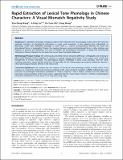| dc.contributor.author | Wang, Xiao-Dong | |
| dc.contributor.author | Liu, A-Ping | |
| dc.contributor.author | Wu, Yinyuan | |
| dc.contributor.author | Wang, Peng | |
| dc.date.accessioned | 2013-04-26T17:43:10Z | |
| dc.date.issued | 2013 | |
| dc.identifier.citation | Wang, Xiao-Dong, A-Ping Liu, Yin-Yuan Wu, and Peng Wang. 2013. Rapid extraction of lexical tone phonology in chinese characters: a visual mismatch negativity study. PLoS ONE 8(2): e56778. | en_US |
| dc.identifier.issn | 1932-6203 | en_US |
| dc.identifier.uri | http://nrs.harvard.edu/urn-3:HUL.InstRepos:10589787 | |
| dc.description.abstract | Background: In alphabetic languages, emerging evidence from behavioral and neuroimaging studies shows the rapid and automatic activation of phonological information in visual word recognition. In the mapping from orthography to phonology, unlike most alphabetic languages in which there is a natural correspondence between the visual and phonological forms, in logographic Chinese, the mapping between visual and phonological forms is rather arbitrary and depends on learning and experience. The issue of whether the phonological information is rapidly and automatically extracted in Chinese characters by the brain has not yet been thoroughly addressed. Methodology/Principal Findings We continuously presented Chinese characters differing in orthography and meaning to adult native Mandarin Chinese speakers to construct a constant varying visual stream. In the stream, most stimuli were homophones of Chinese characters: The phonological features embedded in these visual characters were the same, including consonants, vowels and the lexical tone. Occasionally, the rule of phonology was randomly violated by characters whose phonological features differed in the lexical tone. Conclusions/Significance: We showed that the violation of the lexical tone phonology evoked an early, robust visual response, as revealed by whole-head electrical recordings of the visual mismatch negativity (vMMN), indicating the rapid extraction of phonological information embedded in Chinese characters. Source analysis revealed that the vMMN was involved in neural activations of the visual cortex, suggesting that the visual sensory memory is sensitive to phonological information embedded in visual words at an early processing stage. | en_US |
| dc.language.iso | en_US | en_US |
| dc.publisher | Public Library of Science | en_US |
| dc.relation.isversionof | doi:10.1371/journal.pone.0056778 | en_US |
| dc.relation.hasversion | http://www.ncbi.nlm.nih.gov/pmc/articles/PMC3577723/pdf/ | en_US |
| dash.license | LAA | |
| dc.subject | Biology | en_US |
| dc.subject | Neuroscience | en_US |
| dc.subject | Cognitive Neuroscience | en_US |
| dc.subject | Cognition | en_US |
| dc.subject | Sensory Perception | en_US |
| dc.subject | Psychoacoustics | en_US |
| dc.subject | Psychophysics | en_US |
| dc.subject | Behavioral Neuroscience | en_US |
| dc.subject | Neurolinguistics | en_US |
| dc.subject | Neuropsychology | en_US |
| dc.subject | Social and Behavioral Sciences | en_US |
| dc.subject | Linguistics | en_US |
| dc.subject | Phonology | en_US |
| dc.subject | Psycholinguistics | en_US |
| dc.title | Rapid Extraction of Lexical Tone Phonology in Chinese Characters: A Visual Mismatch Negativity Study | en_US |
| dc.type | Journal Article | en_US |
| dc.description.version | Version of Record | en_US |
| dc.relation.journal | PLoS ONE | en_US |
| dash.depositing.author | Wu, Yinyuan | |
| dc.date.available | 2013-04-26T17:43:10Z | |
| dc.identifier.doi | 10.1371/journal.pone.0056778 | * |
| dash.authorsordered | false | |
| dash.contributor.affiliated | Wu, Yinyuan | |


